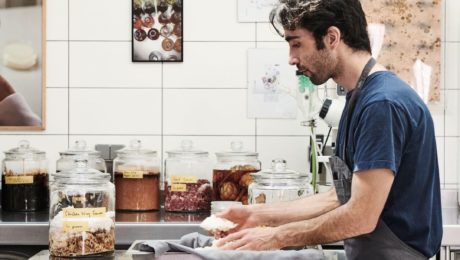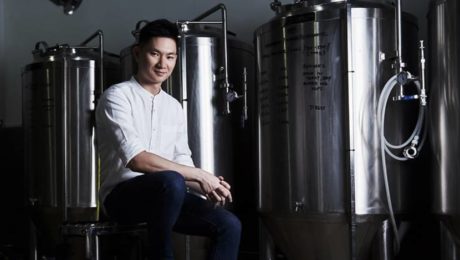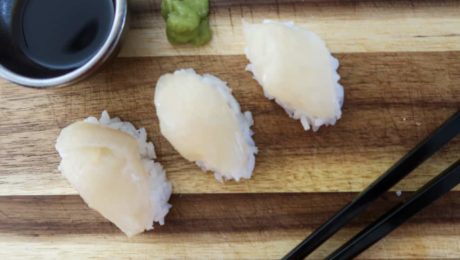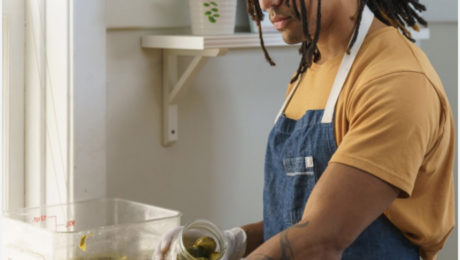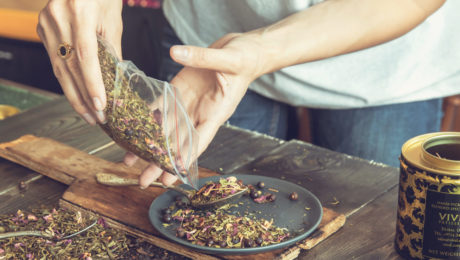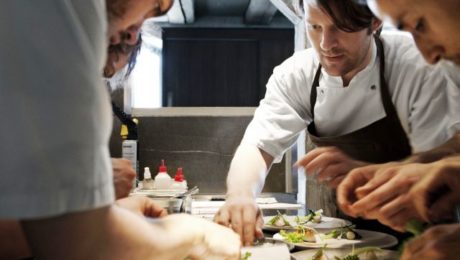Jason White:“It’s Cool to be a Fermenter”
While more chefs and cooking enthusiasts are experimenting with fermentation, they’re skipping the basics and jumping straight to complicated dishes. The foundational steps of cooking are fine-tuned only with time and patience, with hours spent mastering the simple recipes first, according to Jason White, director of the fermentation lab at Noma restaurant.
“It’s just as important for you to make a delicious pickle and a wonderfully balanced kombucha as it is for you to make an incredibly long-aged batch of miso,” White says. “We can never forget that, whenever we start approaching these biological processes and these fermentation processes, that we also take advantage of the beginning stages of learning each individual step along the way. I can’t tell you how important it is for a person who’s emerging into the art of fermentation to stop and pause for a minute and take the opportunity to connect dots. Each microbe that we’re using to ferment things has some kind of mechanism, and an ingredient that we’re going to ferment has a composition that benefits that microbe.”
White spoke at Harvard University’s Science & Cooking Lecture Series, on the topic Fermentation: A Springboard for Modern Gastronomy. He began his director role at Noma last year and has since helped the world-famous restaurant earn its third Michelin star in September.
In his lecture, White stressed observational skills — honed in the early years of learning to ferment — are one of the most important qualities for a fermenter. The best way to “really understand what an ingredient is and what it has to offer a microbe” is through the senses. When you cut into the ingredient, does it feel dry? Does it smell of essential oils? Does it taste overripe?
“Fermentation is one of those weird occurrences in nature where humans intentionally create something only to watch it decompose, and when it decomposes it produces something that’s more valuable to us,” White says. “I am not a chef, I am not a scientist, I am a dreamer and I am a fermenter and my life journey is going to be dedicated to the act of microbial processing.”
From Texas to Denmark, Fermenting with Local Agriculture
A native of Albuquerque, New Mexico, White began a career as a fermentation consultant for restaurants and distilleries in Texas. He worked for two years at Noma before returning to the U.S. in 2019 as head of the food research lab at Audrey restaurant in Nashville.
The early days of his career in gastronomy weren’t spent in beautiful, state-of-the-art kitchens like those at Noma. White’s first experiences as a professional fermenter were spent cooking in a small wooden shed in the Texas heat.
Environment is a critical element to fermenting. Texas is vastly different from the areas that are the globe’s cornerstones of fermentation — Japan, Korea and Taiwan — and which had inspired White. Texas, for example, doesn’t have a huge variety of mushrooms or produce — but it does have chilies and lots of grains.
“I found a lot of joy adapting traditional recipes into something that was based off Texas agriculture,” White says. Much of his fermentation in those days was driven by koji, which grows well on the grains common to Texas.
White learned a key lesson that he incorporates in his cooking: use the local ingredients and agricultural systems available in the area.
“Every single ingredient on earth, you’re going to find something that is valuable to a fermentation process,” White adds. “Even if we can’t consume it as humans, you can use the fermentation process to make it more delicious.”
Respecting the Past, Propelling the Future
Fermentation has been around since the beginning of humanity. When we ferment, White says, we’re recreating the environment and the processes traditionally used where the ferment was first discovered and practiced.
“And, as fermenters, we are also carrying the knowledge of these practices through the generations,” White says. “And where we are with fermentation, it’s kind of like emergent pop cultures. It’s cool to be a fermenter.”
White characterizes his fermentation style as “somewhere between a control freak and a naturalist.” Fermenters have a “huge sense of responsibility” to maintain food safety, carry on traditional processes and teach new fermenters. …We are protectors of knowledge, we are protectors of ingredients and we are protectors of history.”
Whether fermenting at home for personal use or in a production facility for consumers, “We are all still changing the way microbes are evolving and we’re all still participating in the ancient act and it is truly beautiful….if anyone in this room wants to ferment, you are literally the future of fermentation.”
During his presentation, White demonstrated how to ferment persimmons. In Texas, local farmers would bring persimmons to the restaurant where he worked. They were hard and unripe, not flavorful enough to eat raw, so White soaked them in amazake, a fermented rice beverage. During his lecture, White sliced bright orange persimmons for an amazake bath.
“The beauty in this whole entire thing isn’t how complex it is,” White says. “Fermentation doesn’t have to blow your mind, you don’t have to be like ‘Oh my god, it’s completely transformed, it’s something I don’t even recognize and it makes my palate explode with flavor.’ No. Fermentation could also be something that respects an ingredient and leaves it as is. But enhanced fermentation is something that can make something that is not as valuable as it should be more valuable again. You can turn something that would maybe go in the trash…into something very delicious.”
- Published in Food & Flavor
Reviving Singapore’s Fermentation Culture
Singapore’s so-called “Prince of Fermentation” wants his country to develop “its own brand of fermentation culture.” Tan Ding Jie says Singapore’s traditional ferments are often left out of “the gospel of fermentation.”
“Cinchalok, fish sauce, fermented bean curd, fermented bamboo shoots – these are all very interesting ideas. People who are more mature have been quite ready to adapt koji from Japan and red yeast rice from Asia in their Western restaurants – so I think we should also be able to adapt or loan some of their ideas and use them in our cuisine.”
Tan Ding Jie, a researcher for Singapore’s Agency for Science, Technology and Research, is currently pursuing a master’s degree in food science. Jie consults for different Singapore restaurants and bars on how to use ferments in their menus. He created a fish sauce and nata de coco at the Michelin-starred Labyrinth restaurant, and created kombucha-infused cocktails for Gibson, one of Asia’s top bars. He started his own brand, Starter Culture, and teaches fermentation workshops and sells his own kombucha.
In an interview with Channel News Asia, Jie said he thinks there’s “much to be discovered from looking into our Southeast Asian culinary heritage. … I think Singapore is unique because we haven’t been afraid to say, ‘Let’s learn what are the best practices in the world today, and then apply it to our local context.’ If you look at Southeast Asian ferments, it’s also very simple – we took what immigrants brought over and said, ‘All right, that’s the history, let’s make it local.’”
Read more (Channel News Asia)
- Published in Food & Flavor
Alt Fish Protein Launch
A female-led food startup is the first in the world to develop a whole-muscle cut of alternative seafood “meat.” Aqua Cultured Foods, based in Chicago, uses biomass fermentation technology to produce alternative fish products, like filets of tuna and white fish, calamari and shrimp.
The company makes seafood analogs using a proprietary strain of fungi. Vegconomist describes their microbial fermentation process as “growing” protein rather than food processing of a plant-based product. Fermentation allows Aqua Cultured Foods to mimic the taste, texture and nutrients of fish.
“Biomass fermentation delivers a whole, unprocessed seafood alternative that is very different from plant-based seafoods available today. We can adjust the production conditions and inputs to create a different texture, shape, or nutritional profile,” says Anne Palermo, CEO & Co-Founder of Aqua Cultured Foods. “The excitement around these products is coming from several sectors, including restaurant and foodservice as well as fresh refrigerated set for grocery. In the same way some vegan products are now featured in the meat department, ours can be sold alongside animal-based fish at the seafood counter.”
Read more (Vegconomist)
- Published in Food & Flavor
Q&A: Sebastian Vargo, Vargo Brother Ferments
Sebastian Vargo was an up-and-coming chef on the Chicago food scene when the Covid-19 pandemic hit and shuttered restaurants. Laid off from his job as head chef at Merchant Restaurant, Vargo experimented with different gigs — yoga teacher, realtor, even t-shirt graphic designer — but kept coming back to his passion: creating food.
So Vargo and his fiancée, Taylor Hanna, launched Vargo Brother Ferments. They produce a creative line-up of fermented condiments, sauces and beverages, including items like a pickled garlic sauce, chipotle beet sauerkraut, Mighty Vine tomato vinegar, Concord grape kombucha and a Bulgarian yogurt with fermented strawberry jam and miso peanut butter.
“Ultimately, I’m a flavor chaser,” Vargo says. “Fermentation is not really an obligation, it’s a necessity to really unlock certain flavors.”
Most of what they make is seasonal, created from fresh ingredients sourced locally from Chicago community gardens or out of Vargo’s backyard garden. Flavors heralding back to Vargo’s childhood are also featured. Collard greens kimchi is one example, featuring the leafy vegetable frequently served at Vargo’s family dinner table as he grew up in Detroit.
“You can’t help but find a little bit of nostalgia in what you make. Flavors are so connected to memories,” Vargo says. He recalls his mother’s buttery cornbread, her pinto beans flavored with a smoked ham hock and his grandmother’s braised short ribs with sauerkraut. “We were this African-American family in the Midwest in the ‘90s with Southern heritage, so some of my food preserves some of that history. With fermentation, there’s an intersection of both physical preservation and historical preservation. My fermented vegetables are an homage to the past, presenting certain vegetables in interesting and complex ways.”
Vargo and Hanna currently run their business from their home kitchen, selling over Instagram, at farmers markets and through collaborations with local restaurants around the Chicago area. They’re nearing the end of a Go Fund Me campaign to help move Vargo Brother Ferments into a commercial kitchen and, eventually, a storefront. .
Below is an edited Q&A between Vargo and The Fermentation Association.
The Fermentation Association: How did you first get into cooking?
Sebastian Vargo: My origin is with my grandmother. My mom worked really hard, she worked nights and then she was going to school as well. My grandmother was in our household a lot, she taught me and my brothers [the namesake behind Vargo Brother Ferments] a lot of life skills, how to box, how to play basketball, how to cook. I have fond memories of eating sauerkraut as a child out of a coffee mug with a fork. She was my earliest inspiration, I have fond memories of my grandma in the kitchen.
TFA: And how did you get into fermentation?
SV: My grandma introduced me to sauerkraut. It was such an exciting flavor, I hadn’t experienced the brininess of lactic fermentation, the way it feels on my tongue and cheeks. My mom loved to take us to local delis and we loved Reuben sandwiches. We’d go to a lot of Jewish delis in southeast Michigan, and they had salt brine pickles. That was a real fermented pickle, that flavor is something, too, that really kind of jump started my interest in fermentation.
And then, just working with cool chefs. A new part of my mind was unlocked at every restaurant. Great chefs helped cultivate my love of fermentation. Being in the industry in Chicago is so cool. Every last one of us, we’re all trying to experiment and see what we can do with flavors. When I worked for Stephanie Izard at Girl & the Goat, we were doing kimchi for certain dishes. At Schwa with Brian Fisher and later Wilson Bauer, we made our own yogurt and fermented our leeks, our apricots. And then when I worked for Tony Quartaro at Dixie, he was really pushing the envelope with this Southern-style restaurant where we took inspiration from around the world in a way and applied it to this Southern technique. We had some peaches come in that were underripe, we couldn’t use them for the actual dish, so instead he mixed it with some rum and taught me how to make a vinegar out of it.
TFA: What took you from Detroit to cheffing in Chicago?
SV: It was one Le Cordon Bleu commercial. I was young, I was in a bit of a crossroads and I made the decision to go to the Le Cordon Bleu culinary school in Chicago. I was working at the Salvation Army at the time and I got on the Megabus with my little thrift bags and maybe $800. I had no plans, I found out $800 will not get you an apartment in Chicago, so I stayed in hostels. Before I got enough money for culinary school, I worked as a canvasser to make money.
TFA: March 2020. You are the head chef at Logan Square’s Merchant and your fiancée was cooking at the Ace Hotel. Then Covid-19 lockdowns happen. Tell me how your lives changed.
SV: Merchant was the first restaurant where I was head chef, it was fun. We made our own hot sauces, we fermented pickles. But once I had the call that we were closing for Covid, I was ready to figure something out. I was a little bit burnt out from the industry at the time. I was ready to leave, it’d been a lot of pressure and a lot of stress for a while. So, like a lot of Americans, we took the unemployment. I had never been on unemployment. Being unemployed gave me a chance to finally reset. I was working up to 120 hours a week cheffing around. Now I could see what else is out there.
The whole time I was looking outside of the industry, me and Taylor were still doing a lot of experiments in the kitchen. We were making a lot of bagels, making pickles. I have a friend Joe Morski who runs a one-man sandwich operation called Have a Good Sandwich. It’s like a rotating sandwich club in Chicago. Meanwhile, I was trying to start a pickle club, and I asked him if he wanted to serve my pickles in the lunch pack for his sandwiches. That was my first foray into getting my pickles out there. From there, we just started peddling our jars.
TFA: What was the transition to your own business?
SV: To this day, there’s so few fermented, unpasteurized pickles on the market. It wasn’t even a search for a niche, it was something I love to do and I was excited to share my flavor palette with the public. Fermentation is a fun way to be creative, to use it as a platform for new dishes, to play aground with colors. It’s definitely been a great medium to pursue my love of food, of art. Feeding people is my love language. And fermentation is definitely something that’s going to live on forever. It’s wellness, it’s never going to go out of style.
TFA: Tell me about your G-Dilla pickle. That’s a customer favorite. What makes it so special?
SV: The G-Dilla pickle is a flagship that’s always in season. The name G-Dilla, we have blank labels and I didn’t want to write “Garlic Dill” each time. So I started G-Dilla as an homage to J-Dilla, a great producer [and rapper from Detroit].
The taste is akin to a Jewish deli, a garlic dill pickle, the one that would accompany a Reuben sandwich. I just take it kind of a step further with the herbs and the garlic. We use black tea in our pickle brine, it is a fun way to add tannins to the mix which provides that nice, crunchy skin. We really enforce the flavors through fresh herbs, fresh dill from our backyard, parsley, grape leaves, fresh bay leaf and we add lots of garlic and toasted block peppercorn and mustard seed. Maybe a little gochujang, some turmeric. You bite into one and you’re getting that loud crunch and you’re just getting that lactic acid zing that’s electrifying the flavor. It makes you stop what you’re doing, you can’t talk through it, you have to finish chewing and enjoy the whole experience. It’s been a journey — I think back to the first pickle I made to now and it’s something I’ve kept at, I’m a student of the game, always striving to learn more techniques and refine what I’m doing.
TFA: Why do you think more and more chefs are exploring fermentation?
SV: I think so many chefs are seeing the flavor benefits alone. Food fermentation offers a more nuanced flavor that you just can’t achieve the same way. Fermentation is in everything that we do, everything that we eat. There is really an endless source of inspiration and flavor for chefs. We’ve seen the interest pick up in fermentation, but it’s not a fad in the food world. Fermentation is something that is here to stay, with the recent explosion and interest in it, fermentation will find a nice settling place in food.
TFA: What do you think is the future of fermentation?
SV: I would like to see a future in which fermentation is no longer just a trending topic, something that everyone acknowledges for its real health benefits. So people aren’t just taking a probiotic gummy, they know they can get probiotics easily through so many foods. Society is at a place where we are not quite as healthy as we should be. Maybe we can make fermentation convenient, maybe we can show people that it’s not hard, we can show folks that there’s food you can have that has enhanced flavors and there’s something in fermentation for everyone.
- Published in Business, Food & Flavor
Like the Flavor of Black Tea? Thank Fermentation
Tea connoisseurs have long believed that black tea’s flavor comes from the chemicals created during oxidation, but a new study reveals microbes at play. Black’s tea’s rich flavor is partly due to fermentation, the same microbial process used to create fermented teas like kombucha, jun and pu’erh.
What does this mean for tea producers? By adjusting the microbes on the tea leaves, fermentation could amplify the flavor in the final brewed cup of tea.
“The finding that bacterial and fungal communities also drive tea processing suggests the microbiome of the leaves can be manipulated to create greater quantities of tasty compounds due to fermentation,” says Dan Bolton, founder, editor and publisher of Tea Journey.
In research published in the Journal of Agricultural and Food Chemistry, a team of scientists from Anhui Agricultural University in China studied how sterilization of tea leaves affected tea flavor. They began by sampling the microbes on leaves from the Dongzhi tea plantation in Anhui province. Half the leaves were sterilized in mild bleach for five minutes — the other half were left untouched. All the leaves were then processed traditionally: withered, rolled, oxidized in the sun and dried.
Their conclusions found black tea produced through microbial fermentation from the unsterilized sample was full of catechins and L-theanine. Catechins are flavonoids and a naturally-occurring antioxidant; L-theanine is an amino acid (also found in mushrooms) known to ease stress and insomnia. Both compounds help make tea flavorful. The sterilized leaves produced tea that didn’t have the same amount of compounds, and so wasn’t as flavorful.
“The sterilization process dramatically decreased the content of total catechins and theanine in black tea, indicating that microbes on the surface of tea leaf may be involved in maintaining the formation of these important metabolites during black tea processing,” says Ali Inayat Mallano, PhD, professor at the university.
Interestingly, sterilization had no effect on green tea. Both samples of green tea, sterilized and unsterilized, had the same levels of caffeine and theanine.
[To explore premium dark teas, TFA recently organized a webinar Beyond Kombucha: Pu’erh, Jun and Dark Tea with Bolton and tea experts Jeff Fuchs (author, Himalayan explorer and co-founder of Jalam Teas) and Brendan McGill (chef and James Beard nominee who owns Hitchcock Restaurant Group in Seattle and Junbug Kombucha).- Published in Food & Flavor, Science
Noma Finally Earns 3rd Michelin Star
Fourteen years after earning two stars from the Michelin Guide, Noma was finally awarded the illustrious third star.
“After so many years of working together, to finally achieve something like this is extremely special,” says René Redzepi, chef and co-owner of the Copenhagen-based restaurant, during Michelin’s ceremony for Nordic countries earlier this month. Redzepi said the announcement left him surprised and flabbergasted. “I’m completely blown away, it’s a new feeling for me. This opportunity happens once in your lifetime.”
Long lauded as one of the top restaurants in the world, Noma has an innovative fermentation lab and test kitchen that creates wildly imaginative and ingenious dishes. Their summer menu featured an edible candle made with cardamom, saffron and a wick of silvered walnut; a salad made with reindeer penis; and a cold-pressed beetroot juice served in a flower pot adorned with a ladybug made from raspberry and black garlic .
The reactions from food industry professionals echoed the same sentiment — the third star was overdue.
James Spreadsbury, restaurant manager at Noma, said during the ceremony that the staff at the restaurant has been patient. “At some point, we kept on and didn’t expect anything would change. But we were still so proud of what we did and believed in what we did. After so many years of working together, to finally achieve something like this is extremely special.”
Redzepi was also honored by Michelin. The Chef Mentor award, given annually to a chef sharing their knowledge to help others, was presented to him by Peyman Sabet, the vice president of business development for Michelin.
“It’s really about innovation and making the path for a new generation of chefs,” Sabet said.
Redzepi said he was humbled to receive the award. He noted that, when Noma opened 18 years ago, “I was a terrible leader…when you are in the industry, you find yourself becoming a head chef and you don’t have the tools to actually figure out how are you doing to do this, how are you doing to lead and inspire a team.”
He said years ago he “promised himself this is not who I wanted to be.”
“One of the most enjoyable things I have in my professional career is to see someone that’s been a part of your own success, but when they leave they have their own success. That’s really really enjoyable.”
Noma is proud of their alumni and highlights them on their website. Reads the webpage: “Our chef René was himself a stagiaire [a cook who works briefly, for free, in another chef’s kitchen] around the world before opening Noma. It is a part of sharing ideas and knowledge that is quite special in our trade. We wouldn’t want to be without stagiaires and we believe that everyone that has been through Noma shares in part of our success.”
Former Noma chefs include: David Zilber (nowat bioscience company Chr. Hansen), Thomas Frebel (head chef at INUA in Tokyo), Dan Giusti (founder of chef training company Brigaid), Matt Orlando (head chef at Amass Restaurant in Copenhagen), Søren Ledet (owner and restaurant manager at Geranium in Copenhagen) andMads Refslund (head chef of ACME in New York City)
- Published in Business, Food & Flavor
Native American Brewery with Traditional Flavors
Bow & Arrow Brewing in New Mexico is part of two small but growing groups in the U.S. — it is both female- and Native American-owned.
Bow & Arrow locally sources their traditional Native American ingredients (blue corn, Navajo tea, three-leaf sumac) for their seasonal sour beers. The hops they use — subspecies neomexicanus — were used for their antiviral properties by the Navajo people in the Southwest,who put them in teas and salves. The brewery owners — Missy Begay and Shyla Sheppard — forage for hops in the mountains near Albuquerque. They also give their spent brewing grains to a local Native American family for use as feed for their livestock.
Begay, pictured left (who is Diné [Navajo]) and Sheppard, pictured right (a member of the Three Affiliated Tribes [Mandan, Hidatsa, and Arikara]) met at Stanford University in 2000. They took different career paths, but both fell in love with craft beer and homebrewing. They opened Bow & Arrow Brewing Co. in 2016.
“There is a sweetness to the land here, and all of this is sacred. We hope, as Native American women brewery owners, that people understand the story we have to tell,” Begay says.
Read more (Outside)
- Published in Business, Food & Flavor
The Fermentation-Flavor Connection in Chocolate
Cacao would never obtain its rich flavor profile without a traditional food processing technique: fermentation.
“I feel like fermentation adds about three-quarters of the flavor to the finished chocolate. I think it is the most important step in the entire tree-to-bar process for the flavor of the chocolate, and the chocolate makers have been taking too much credit for the flavor of their chocolate,” says Nat Bletter, PhD and founder of Madre Chocolate.
Chocolate makers “can definitely take a great grown and fermented cacao and make it shine, but it’s really hard to take a badly grown and fermented cacao and make a good tasting chocolate and that’s why so much of the world’s chocolate is loaded with milk and sugar to try to cover up some of the bad fermentation flavors.”
Bletter joined Max Wax (vice president of Rizek Cacao) and Dan O’Doherty (principal of Cacao Services) in sharing their expertise during a joint webinar, The Fermentation-Flavor Connection in Chocolate., co-hosted byThe Fine Chocolate Industry Association and The Fermentation Association..
The three speakers work in different size chocolate operations. Madre Chocolate is a small-scale chocolate making company in Honolulu that uses cacao from small Hawaiian farmers; Rizek Cacao is a producer and exporter of cacao and cacao products based in the Dominican Republic; and Cacao Services (also in Honolulu) s an agricultural and scientific consulting company that specifically focuses on cacao production systems.
Complex fermentation
Cacao fermentation is among the most complex of food ferments because it utilizes three families of microbes and 5-10 species in each. “It is a little bit hard to control since it’s not just one single species of microbes that you’re trying to support a good ecosystem,” Bletter adds.
Wax attributes less of chocolate’s flavor to fermentation. He says there are flavors produced by the metabolism of the plant itself, “so genetics is probably No. 1, then comes the terroir that comes with fermentation. We shouldn’t be dogmatic on fermentation but on the contrary open to this fantastic dialogue between wisdom and science.”
A chocolate maker is responsible for studying the effects of yeasts on their cacao ferment, Wax adds. They should ask: How does the naturally occurring yeast change flavor? What’s the metabolism rate? Is there a possibility of naturally inoculating the cacao for a different flavor?
“It is absolutely true that you should not inoculate something using either commercial yeast or yeast from grapes or other types of culture, or even from different environments,” Wax says. “But it is also true that the variety of yeast that is naturally occurring, not all of them give the same taste profile. … Nobody wants the same flavor and the same cacao forever, just as we don’t want the same wine or the same cheese or the same yogurt or the same beer.”
Rizek Cacao employs 32 varieties of yeast in their chocolate.
Sensory Cues
O’Doherty, who works with cacao farmers, says it’s possible to ferment cacao without any kind of quantitative measuring devices.
“If you’re an experienced fermenter and you really know what you’re looking at, you use all your senses,” O’Doherty says. A fermented cacao bean will be plump and juicy; the color will be reddish-brown (a pale bean is under-fermented) and the bean’s scent will change depending on the stage of the fermentation process.
“If I only had one sense to go on for cacao fermentation, I think it really would be aroma,” O’Doherty continues. The scent sequence will begin as fresh and fruity, transition to a strong yeast fragrance, next to wine , then to ethanol and, finally, the sharp vinegar scent will fade to a fruity vinegar.
One of the topics mostly frequently raised by cacao producers, says O’Doherty,is how to modernize their operations. He points out that most cacao farmers still ferment using boxes and heaps.
“In general, cacao cultivation and processing is centuries behind,” he says. Most cacao farms are run by small shareholders who don’t have the money for barrels or stainless steel equipment. “Sophisticated fermentation vessels are not really an option for consideration. Truth be told, well executed, both heaps and wooden box fermentations can produce some absolutely fantastic cacao.”
O’Doherty concludes: “The larger question about commodity cacao and the incentives or lack thereof is the reason that I have a job helping farmers with fermentation. Although there may be traditions, there’s no feedback mechanism. There is no incentive for good quality and, typically, there’s really not a penalty for bad quality, unless it is actually decomposing…a lot of the work I do is linking these producers that I assist with their harvest and process to chocolate makers that will pay double or triple the typical commodity price. I still don’t think that’s enough but it’s moving the needle in the right direction.”
- Published in Food & Flavor
Reviving Sake with SoCal Style
James Jin of Nova Brewing Co. doesn’t want to create a Japanese-style sake — he’s working to create a Southern Californian sake.
Jin uses Calrose rice grown near Sacramento, imports koji and yeast from Japan and designs his own brewing equipment. The flavor of his modern sake is thanks to a secret blend he uses to make the koji rice (the base for the sake), utilizing both yellow and black koji spores, as well as yeast from the Brewing Society of Japan. The flavor — more wine-like, fruitier, higher in acidity and easily paired with food — “it’s a lot more appealing to the younger generation.”
“I respect the history of sake brewing, but it’s a dying art in Japan,” Jin says, adding, “Sales of sake [are] constantly going down [there]. I’m one of the few brewers in America trying to bring the dying art back to life.”
“I’m not a Japanese brewer. I’m an American brewer. I purposefully do things they wouldn’t do in Japan.”
Nova Brewing produces four sakes and 10 craft beers at their facility in Covina, California. They are the only craft sake brewery and tasting room in Los Angeles County — and the only sake and beer hybrid producer in California.
Read more (Los Angeles Times)
- Published in Business, Food & Flavor
Alcohol Levels in Wine Continue to Rise
The alcohol levels in wine have been rising over the past 30 years — and wine experts say the sugar content in grapes is to blame.
Though a winemaker can manipulate sugar levels in the vineyard and alcohol levels in the cellar, a hotter climate is driving increased sugar content in grapes. California’s wine grapes have had a “substantial rise” in sugar levels since 1980. A study by the American Association of Wine Economists (AAWE) hypothesizes global warming is contributing.
Read more (Decanter)
- Published in Food & Flavor

